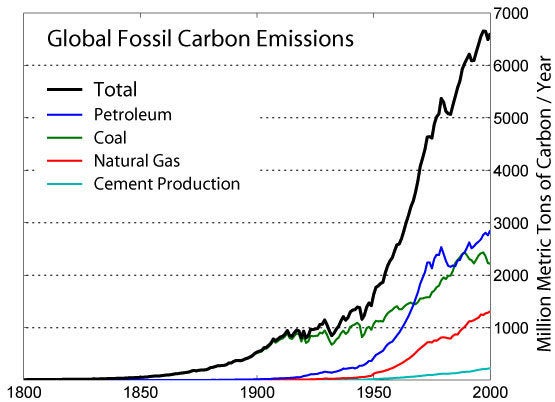It's tempting to write that, like politics, all pollution is local. After all, we experience the effects of smog in our lungs or fouled water in our bellies in a profoundly personal way. When it comes to cities and climate, however, what we experience locally has a much larger context: our planet.
In aggregate, greenhouse gas emissions from humans are changing our world, and since most of us are living in cities, the actions that our mayors, city councils and communities take will matter both locally and globally. Community leaders can often take similar steps to reach a shared set of goals because cities face many of the same problems, when it comes to the climate. Along the way, it's important that these leaders encourage the formation of new habits and create disincentives for actions that everyone agrees are harmful.
Ahead of the United Nations Climate Change Conference in Paris, the C40, a global network of 81 huge cities, released a new report outlining the results of a decade of collaboration. Seeking ways to measure and reduce emissions and mitigate the effects of climate change, C40's research identified patterns in the adaptation actions of different cities.
However, the most common actions highlighted in the report -- building or improving storm water capture systems, installing roofs and walls covered with vegetation, developing crisis management systems, engaging in flood mapping and planting trees -- focus merely on response.
Tilting the balance toward low-carbon cities will require giving billions of people incentives to make different choices about how they live, work and travel. It will also mean partnering with the private sector to save energy, reinvent how services are delivered, build the next generation of mass transit systems and make daily life more sustainable.
Curbing emissions and pollution will require concerted efforts to change how energy is generated and used, but mayors have to justify spending taxpayer dollars on new technology and policies with clear cost savings and returns on public health.
Here are three strategies mayors can pursue that could change the way people, communities and economies think and act, not just react:
1) Shift toward conscious consumption
Tech companies, driven by the imperatives of meeting quarterly goals for investors, urge consumers to buy their latest products, from smartphones to tablets to laptops to televisions and wearable devices. Sustainability has to become balanced with planned obsolescence as a cultural value.
Beyond culture, cities will need to collaborate with schools, nonprofits, industry and media to fix what can be saved and recycle electronic waste from the rest. Reclaiming rare earths and useful metals and separating toxic components doesn't just make economic sense: keeping them out of dumps also prevents them from poisoning communities elsewhere.
Tech giants like Apple have worked to shift to renewable energy sources. Cities can do the same. Mayors and city councils can use procurement reform to ensure that vendors compete to host the next generation of digital city services in greener data centers powered by clean energy sources instead of coal-fired plants.
2) Create incentives for collaborative consumption
We know that walking and cycling are good for your health and good for the environment, but they can be dangerous in cities that aren't built to accommodate multi-modal forms of transportation. The trouble is that cities and suburbs designed around gasoline-powered cars aren't going to change overnight.
Cities need to find ways to get more people into low-emissions cars, get more people to carpool and get people out of cars altogether.
In the near term, cities can approach startups like Uber and Lyft as partners in meeting the transportation needs of residents, from sharing data to forging new labor and consumer protections. Cities will need to pair increasing use of carpooling and ride-sharing with regulations that ensure accessibility and safety.
In the long term, congestion taxes on cars -- like the charge instituted in London in 2003 -- can reduce traffic and increase cycling and mass transit use. They also create revenues that can then be reinvested in subways and buses that run on renewable energy sources.
There are other levers, too. Oslo, the capitol of Norway, has been working to convert all city-owned cars to electric vehicles. To get there, the city has tried to make it easier and cheaper to be greener, offering free public charging points, free access to toll roads and tax incentives. A fifth of new car sales in Norway are now e-cars, aided in no small part by the country's decision to exempt these vehicles from a 25 percent sales tax and an expensive registration tax.
3) Find a baseline for emissions and measure progress
It's hard to determine the impact of efforts to reduce emissions and pollution if you aren't effectively measuring these reductions. That's why greenhouse gas inventories matter: Cities need to understand where pollution is coming from.
Mayors must be able to report meaningful results -- numbers, not just words -- back to residents. To do so, cities must systematically identify the sources of emissions, set targets for reducing them, make priorities for migrating sources to renewable energy generation and track the performance of these activities. Increasingly inexpensive sensors embedded into streets, garages, businesses, factories, homes and cars can help, providing public health and environmental agencies with rich data to analyze and visualize trends.
Structuring and analyzing a city's internal administrative and operational data gives regulators new tools to find patterns of violation and health code violations. This saves lives and enhances the effectiveness of inspectors. All of that data enables urban planners to find hotspots and work with cities to reduce traffic congestion and associated smog.
When public health agencies publish that air pollution and water quality data, they not only inform residents of health risks: They put public pressure on polluters.
Sometimes, the official record may not be enough on its own. If cities view the public as a resource, residents can help to monitor problems and progress, too. Residents with smartphones can report environmental hazards, pollution, illegal dumping or damage from storms. Independent readings taken by media organizations, technology companies and citizen scientists will complement official readings. Together, they will shine a light on corruption and lax regulation.
- What You Need To Know About The Paris Climate Summit
- After Years Of Lukewarm Climate Talks, Paris Cranks Up The Heat
- How To Talk To A Climate Change Denier
- Watch How Rising Sea Levels Could Swallow Coastal Cities
- Why Some Conservatives Still Won't Accept Climate Change Is Real
- The Devastating Consequences Of A 'Small' Rise In Global Temperatures
- Mayors Take On Crucial Roles Fighting Climate Change
- Why This Goal To Curb Climate Change 'Is Not Ideal'
- Here's All The Nonsense 2016 Republicans Have Spouted About Climate Change
- How Tech Is Pulling Ahead Of Politics In The Fight For Our Future
- These Will Be The Biggest Losers If We Don’t Properly Address Climate Change
- This Is The Beginning Of The End Of The Fossil Fuel Industry
Also on HuffPost:

